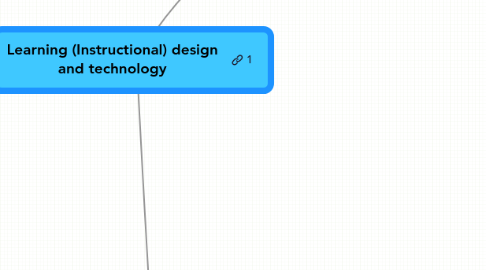
1. Background
1.1. Objective
1.2. Context
1.2.1. Schools
1.2.2. Vocational Training
1.2.3. Commercial (eg. Computer Manufacturing Companies - HP)
1.2.4. T&D On Demand
1.3. Scope
1.3.1. ICT in class
1.3.2. e-Learning
1.3.3. Hybrid (Partly distance learning)
1.4. Definition
1.4.1. Reiser (2001)
1.4.2. Jonassen (1999)
2. Categories of activities
2.1. Instructional Media (Hard)
2.1.1. History on Instructional Media
2.1.1.1. Definition
2.1.1.1.1. Physical means via instruction is presented to learners
2.1.1.2. Examples
2.1.1.2.1. 1900's: School Museums
2.1.1.2.2. 1910's: Instructional Films
2.1.1.2.3. 1930's: Radios
2.1.1.2.4. 1940's: Audiovisual devices
2.1.1.2.5. 1950's: Instructional TV
2.1.1.2.6. 1950's-1995: Computers (CAI)
2.1.1.3. Problems of the old instructional media
2.1.1.3.1. A mean of having learner interacts with instructional content only
2.1.2. Trend of Instructional Media
2.1.2.1. 1995 onwards: Computers with Internet Connection
2.1.2.1.1. Increasing multimedia capabilities
2.1.2.1.2. New instruction media come more slowly than expected by enthusiasts
2.1.2.2. After 1999: Web 2.0
2.1.2.2.1. Wiki
2.1.2.2.2. Blog
2.1.2.2.3. Social Space
2.1.2.2.4. RSS
2.1.2.2.5. Podcast
2.1.2.3. Latest Trend: Mobile Learning
2.1.2.3.1. Types of Educational applications
2.2. Instructional Design (Soft)
2.2.1. What is the instructional design?
2.2.2. Evolving Learning Theories
2.2.2.1. 1st : Behaviorism
2.2.2.1.1. Overview
2.2.2.1.2. Instructional Design Example
2.2.2.2. 2nd: Cognitivism
2.2.2.2.1. Overview
2.2.2.2.2. Nature of human learning base on Cognitive Science research
2.2.2.3. 3rd: Constructivism
2.2.2.3.1. Overview
2.2.2.3.2. Instructional Design Implications
2.2.2.3.3. Model of Constructivist Learning Environment
2.2.2.3.4. Youtube Video on Constructivism
2.2.2.3.5. Instruction Design Example
2.2.3. Conclusion: There is no one best Learning Theory in the world
2.2.3.1. Behavioral Approach: For facilitate Mastery and learning background information, require low degree of processing by learners
2.2.3.1.1. e.g. Lectures Sessions
2.2.3.2. Cognitive Approach: For teaching problem-solving tactics. For learners that have enough contextual knowledge
2.2.3.2.1. e.g. Laboratory Sessions
2.2.3.3. Constructive Approach: For dealing with ill-defined problems, demand high levels of processing. Highest level of thinking
2.2.3.3.1. e.g. Project-Based Learning
3. Instructional Design in Action
3.1. Dominant Areas
3.1.1. Student-centered learning
3.1.2. Direct Instruction
3.1.2.1. Example
3.2. Teaching Strategy
3.2.1. REAL
3.2.1.1. Reciprocal teaching
3.2.1.2. Problem-Based Learning
3.2.1.3. Cognitive Apprenticeship
3.2.1.4. Anchored Instruction
3.2.2. Resources-Based Learning (RBLE)
3.2.2.1. Before the "Digital Age"
3.2.2.2. During the "Digital Age"
3.2.2.2.1. Component 1: Resources
3.2.2.2.2. Component 2: Contexts
3.2.2.2.3. Component 3: Tools
3.2.2.2.4. Component 4: Scaffolds
3.2.2.3. Real-life example using RBLE
3.3. Assessment Strategy
3.3.1. Contextualized, complex intellectual, Not MC
3.4. Design
3.4.1. Design Methods
3.4.1.1. Multimedia Effect
3.4.1.2. Coherence Effect
3.4.1.3. Spatial Contiguity Effect
3.4.1.4. Personalization Effect
3.4.2. Design Theory
3.4.2.1. Multimedia Learning Theory
3.4.2.2. 4C/ID Theory
3.4.2.3. Learning by doing
